Kuwait's first oil strike was in 1938 and oil exports began in 1946. Whilst oil remains a major source of GDP, manufacturing industries, petrochemicals, foodstuffs, building materials, trade, real estate, communications and transport are all playing increasingly important roles in the national economy. Kuwait has also shared the benefits of its oil wealth with other countries and the Kuwait Fund for Arab Economic Development has helped many worthwhile development projects.
Kuwait's solid infrastructure, developed as a result of prudent use of its oil revenues, includes over 5,000 kms of high grade roads; over 6,898 megawatts of electricity capacity, and desalination production of more than 234 million imperial gallons per day.
Government
Kuwait became an
independent and sovereign state in June 19, 1961, with the cancellation by
Sheikh Abdullah Al Salem Al Sabah, of the agreement signed between Kuwait
and Britain in January 23, 1899. The draft Constitution, approved on
November 11, 1961, describes Kuwait;s system of government as follows:
"Kuwait is a fully independent Arab State with a democratic style of
government, where sovereignty rests with the nation, which is the source
of power." As prescribed by the Constitution, the system of
government is based on the separation of powers. The legislative authority
is vested exclusively in the Amir and the National Assembly, while
executive power is vested exclusively in the Amir and his Cabinet and
Ministers. The Constitution itself comprises 183 articles in five separate
chapters. The government system is firmly based on democratic principles
and incorporates positive aspects of both presidential and parliamentary
systems prevalent in advanced democratic countries. The pillars of the
Constitution are the sovereignty of the State, public freedom and equality
before the law.
Kuwait's Amiri succession is through descendants of the late Mubarak Al
Sabah and the present Amir is HH Sheikh Jaber Al Ahmad Al JAber Al Sabah.
As Head of the State Sheikh Jaber exercises his authority through his
ministers. The prime Minister and cabinet ministers are collectively
responsible to him for the general policy of the State and each minister
is individually responsible for his own ministry. The Amir also fulfills
the role of Supreme Commander of the Armed Forces. Laws must be approved
by the National Assembly and sanctioned by the Amir before being enforced.
Country
The total area of the State
of Kuwait is 17,818 sq kms (6969 square miles). Kuwait's desert plain
slopes gradually from the west, where it reaches 300m above sea-level, to
the Gulf's shores. A number of discontinuities occur on the form of low
depressions, sand dunes and escarpments. These include Al-Liyah, Kura Al-Maru,
Shagaat Al-Jleeb, and Afrie which forms a ridge at Jal al-Zor (145 meters
high), cut by the Umm al-Ramam wadi. The southern part of Kuwait is
generally flat, with the exception of the slight rise of ground around
Ahmadi whose low hill reaches just 137m above sea level.
The Kuwait mainland, having no mountains or rivers or other natural
features, was for a long time a transit area for nomadic tribes and
caravans. Such freedom of movement made delineation of borders rather
difficult and resulted in some border problems. The whole matter was
amicably resolved following the creation of the Neutral Zone between the
State of Kuwait and the Kingdom of Saudi Arabia on 7 July 1965. The
northern part of the partitioned zone is administered by Kuwait, whilst
the southern part is the administrative responsibility of Saudi Arabia.
The crude oil extracted from the partitioned zone is shared equally by
both countries.
Kuwait has nine islands off its coast, i.e Failaka, Bubiyan, Miskan, Warba,
Auhha, Umm al-Maradim, Umm al-Nmal, Kubbar and Qaruh. Bubiyan is the
largest island (863 sq kms) and is connected to the mainland by a steel
bridge. Warba, located at the northern extremity of the Gulf, occupies an
area of 37 sq kms. Miskan lies to the north of Failaka island while Auhha
is to Failaka's south. Umm al-Naml is in the mouth of Kuwait bay and has a
rich Islamic history. Kubbar, Qaruh, and Umm al-Maradim are situated
towards the southern section of Kuwait's territorial waters. The island of
Failaka, which is pronounced "Failacha" in the local dialect, is
the most attractive and well known of Kuwait's islands.
History
Kuwait, or officially the
State of Kuwait, was referred to by the name Qurain (or Grane) in the
early 17th century. The names Qurain or Kuwait are diminutives of the
Arabic words Qarn and Kout. Qarn is a high hill and Kout is a fortress. In
the dialect of neighbouring countries, Kout means a house built in the
form of a fortress and adjacent to water. The plural of Kout is Akwat, as
used by the Arabian peninsula's historians when they referred to a number
of castles in towns with forts and walls. Some historians believe that
Barrak, Sheikh of the Bani Khalid tribe, built Kuwait in Grane and that
since then the city has been mostly referred to by the name Kuwait. This
agrees with the local oral tradition that Sheikh Barrak ibn Ghurair Al
Hamid, wh ruled the Bani Khalid tribe from 1669 to 1682, built Kuwait
before the beginning of the 18th century AD, i.e. 12th century AH.
The Danish traveller Carsten Niebuhr depicted Kuwait as Grane on his map
and in the narrative about his Arabia Felix expedition, undertaken in
1765. Furthermore, Kuwait was still known by the name Grane under the rule
of Sheikh Abdullah bin Sabah, the second ruler of Kuwait (1762-1812).
Several places in southern Kuwait still bear the name Grane (Qurain).
Archaeological investigations began in 1958 with the work of a Danish
archaeological mission which excavated mainly in the south of the island,
uncovering remains of the Dilmunite city from the Bronze Age, together
with various Greek remains from the period 300-100 BC, including remains
of houses, temples and a large fortress. The Greeks called Failaka Ikaros
a Greek island in the Aegan Sea.
In 1985 a French archaeological expedition, in collaboration with Kuwait
National Museum staff, uncovered more artfacts a Tell Khazneh on the
island, which offered more evidence of continued life in that region
during the Hellenistic period extending from the sixth century BC to the
third century BC. A sandstone block contained a dedication in Greek by
Soteles to Zeus, Poseidon and Artemis. Among the numerous artfacts
discovered here are horse and camel figurines, Hellenistic bowls and
nearly 450 Bronze Age steatite seals whose designs confirm links with
Bahrain (Dilmun), Mesopotamia and the Indus valley. From such finds
archaeologists have been able to draw a preliminary picture of the ancient
Gulf's history and the early civilisations.
The Kuwait National Museum was established to preserve and celebrate
aspects of Kuwait's heritage and culture that might otherwise have been
subsumed by the modern age. It also serves as a center for research,
investigation, and preservation of valuable artefacts from the nation's
past.
Heritage and Culture
Kuwait pays special
attention to encouraging and refining the folk arts which reflect its
strong folkloric traditions. The Folklore Preservation Center collects,
records and classifies Kuwaiti folklore. Since 1982 folklore has been
included within the curricula of local schools and as a subject studied by
students of music, theater and fine arts. The national Council for Culture
Arts and Letters is responsible for cultural planning, promotion and
development and has helped to provide the cultural planning, promotion and
development and has helped to provide the appropriate atmosphere for
artistic and literary productions. The Council assumes the responsibility
for disseminating culture and fine arts, the preservation and study of the
national heritage, and the fostering of humanitarian bonds and ties
through cultural exchanges at Arab and international levels.
The National Council is also responsible for running 26 public libraries
spread throughout residential
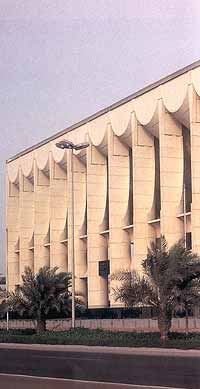
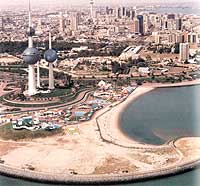
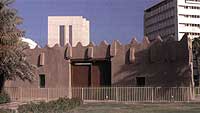
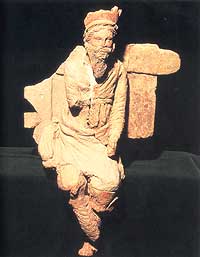
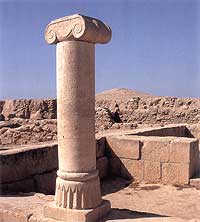
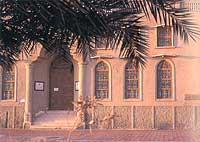
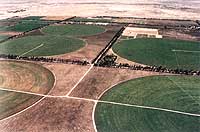
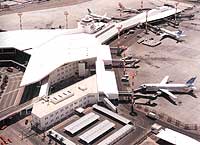
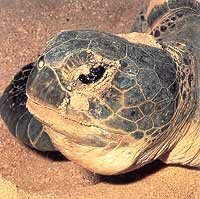
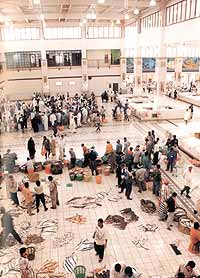
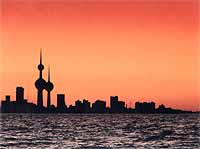
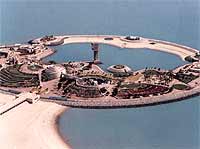
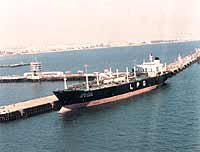

Youth culture is encouraged through free annual art exhibitions and at special studios for free art established in residential areas. The Council sponsors festivals and scientific symposia dedicated for young peoples' culture, and participates in many exhibitions and competitions. Through organising Cultural Weeks in Kuwait and abroad the Council enhances cultural relations on an international level.
Bedouin art, the most characteristic expression of Kuwaiti folk arts, best illustrated by weaving of clothes, rugs and other products from sheep wool - an art known as Al-Sadu - is preserved and actively undertaken at Al-Sadu House, a cultural philanthropic institution which has attracted a group of bedouin women on a permanent basis to provide a constant supply of Sadu. Local residents and foreign visitors are always keen to own this bedouin textile in their homes.
There are numerous folklore troupes performing popular dances and these receive annual support from the government in order to promote heritage cultures. In addition Kuwait Television has formed the Kuwait Television Folklore Troupe which has acquired world renown in presenting Kuwaiti folklore abroad through its performances and popular dances at various world festivals.
The Ministry of Information plays an important role in the development of the formative art movement in Kuwait. It holds art exhibitions within Kuwait and abroad, and publishes artist's catalogues and drawings. The Kuwaiti Society for Formative Arts is a non-profit making society which holds an annual exhibition for its members and another for all artists resident in Kuwait.
The theater in Kuwait is also of importance as a cultural center. There are currently several theatrical companies in Kuwait, most prominent of which are the Gulf Theater, the Arab Theater, the Popular Theater and the Kuwaiti Theater. The Higher Institute for Theatrical Arts exists to provide special facilities for talented Kuwaiti actors, dancers and musicians.
Environment and Wildlife
Kuwait's climate has a
dramatic effect on its general environment and wildlife. The weather is
characterised by long, hot and dry summers, followed by short warm and
sometimes rainy winters. Dust storms are general associated with a rise in
humidity during summer. The highest temperature so far recorded is 51oC
, whilst the lowest is 6oC. Annual rainfall figures may
fluctuate widely, for example from 22mm in one year to 352mm the next.
Despite its desert conditions and wide climatic extremes, Kuwait has a
rich and fascinating plant life with species able to survive the
challenging conditions of aridity, saline soils and unpredictable
rainfall. The country's flora has been the subject of a number of studies.
Identifiable plant communities each have main characteristic species such
as Salicornia hebacea; Juncus arabicus; Halocnemon strobilaceum, Tamarix
passerionoides, Zygophyllum coccineum, or Phragmites australis. Four major
zones have been defined, based upon their plant cover. These are the
Haloxylon salicornicum zone, primarly in the north and west but with some
pockets on the coast, facing Bubiyan island and in the north of Kuwait
Bay; a Rhanterium epapposum zone which is the main zone on the eastern
coastal plain, south of Kuwait Bay; a Cyperus conglomeratus zone which
cuts a swathe through the center of the country and finally a coastal dune
and salt marsh community which effectively borders the entire coastline.
In addition to its plant life, and inextricably linked to it, is a
considerable list of animal species, including arachnids, insects,
reptiles, mammals and birds.
In addition there is a rich marine fauna including sea-weeds, sea-grasses,
many invertebrates, including some corals, fish, turtles and some marine
mammals.
Economic Development
Kuwait's economy is based
on long, medium and short term planning, freedom of initiatives and social
responsibility of the private sector as laid down by the country's
Constitution. Figures for 1996 indicate a GDP of KD 9,277.1 million. The
main sources of the GDP are oil, manufacturing industries, petrochemicals,
foodstuffs, building materials, trade, real estate and communications and
transport. Revenues from foreign investments play a vital role as a source
of national income and in boosting the state's revenues. Oil revenues
contributed KD 4,127.4 million to the GDP i.e. 44.5 percent, while the oil
sector as a whole (crude oil and related oil industries) contributed
approximately 52.2 percent to the GDP. The Kuwait Fund for Arab Economic
Development has offered many loans and considerable assistance to Arab
countries including some African, Asian and other developing nations. In
response to HH the Emir of Kuwait's speech at the UN General Assembly on
September 27, 1990, regarding reduction of the debt burden on developing
nations, the Kuwait Fund for Arab Development cancelled interest due on
its loans to 26 African, 12 Asian and nine Arab Countries.
Kuwait has a solid infrastructure, which has been developed as a result of
prudent use of its oil revenues. Its overall road network in 1995 exceeded
4900 kms; its total 1995 electricity power capacity exceeded 6898
megawatts, while its desalination plants produced plants produced 234
million imperial gallons per day and 382,287 telephone lines were
installed. More recent figures show significant increases in each of these
figures.
Kuwait's leisure facilities include public parks, the Kuwait towers, a fun
city, a fun water-park and sharing rinks. These are complemented by first
class hotels and service. Statistics from 1996 list 12 high class hotels
with 2528 rooms, six of which are five-star hotels with a capacity of 1577
rooms and five first class hotels with 447 rooms. These were occupied by
61,718 visitors for 204,976 nights. Figures for visitors to tourist sites
reached 2,531,234 people in 1996.
Kuwait prides itself on being the first country in OPEC to move beyond its
national boundaries in oil exploration by establishing the Kuwaiti Company
for Overseas Petroleum Exploration, and by investing in overseas oil
companies such as the Santa Fe Oil Company. This enabled a dramatic
extension of production, operational and marketing flexibility, increasing
the significance of Kuwaiti national petroleum companies which also
purchased or established several major oil refineries and distribution
centers overseas, particularly in western Europe. The process helped
Kuwait achieve integration in upstream and downstream oil operations,
making it less reliant on the services of third parties.
Social Development
Health care has been a
priority of the Kuwaiti government's agenda. By the end of 195, the number
of government hospitals rose to 16, well-equipped with the latest health
services and equipment, along with 71 health centers, 75 clinics
specialised in dentistry and diabetes, 86 maternity and child care
centers, and 55 preventive medicine centers. In addition to these
facilities a vibrant private medical sector exists. These health
establishments employ 15,404 physicians, pharmacists and nursing staff.
State-of-the-art government hospitals have over 4400 beds.
Education represents the cornerstone of comprehensive development as it
deals with the human resource. The government is firmly committed to
providing a place for every citizen at each educational level, and
education is obligatory from 6 to 14 years old. General education level
consists of elementary, intermediate and secondary levels with 861 schools
and institutions in 1995, out of which 586 were governmental,
accommodating 280,709 students, with an approximately 50:50 sex ratio.
Private schools had (113,857) students of whom 52,991 were female.
Kuwait University offers a broad range of academic courses in the
humanities as well as scientific asn social specialisations. In the
1995-1996 academic year there were 16,691 students registered, out of
which 15,163 were Kuwaitis and 906 were from other Arab Gulf countries.
There were 845 teaching staff from different Arab and foreign countries.
General and university educational establishments are complemented by
applied education facilities which prepare specialised personnel in a
variety of fields including technology, education, commercial, health
studies, communications, surveying, electricity and water technologies,
industrial training and nursing. The total of registered students in these
institutes and training courses in 1995-1996 reached 4355 out of whom 4248
were Kuwaitis.
Adult Education and Illiteracy Eradication Centers provide courses for
adults, illiterate, paralyzed and handicapped people. By 1995-1990 there
were 67 centers with 377 classes with 13,200 students and 1293 teachers.
The Kuwaiti government has paid special attention to promotion of youth
skills and talents. To this end, eight youth centers have been established
to accommodate (1995-1996) 8297 young males and females. On the other
hand, there were 36 training centers supervised jointly by the youth and
education sectors with 1310 students.
Kuwait has 14 sport federations with 21 clubs and over 40,000 members.
There are also specialised youth centers such as the Abdullah Al Salem
Center for Rehabilitation Youth Leaders as well as the sport centers for
women. The Boy Scouts has over 2600 members and youth hostels provide
services for about 500 people annually.
Kuwait at a Glance
Location: Kuwait lies at the north western part of the Arabian Gulf which also borders it from the east. Kuwait is also bordered by Saudi Arabia from the south west, and Iraq from the north. As a result of its location, it is considered an access point to the north-eastern of Arabia.
Area: 17,818 sq.km.
Climate: Kuwait's climate is characterised by a long hot dry summer, and a short warm winter with intermittent rain.
Population: 2,152,775 according to estimates of June 30, 1997, of whom 745,189 are Kuwaitis.
National Day: February 25.
Liberation Day: February 26.
Religion: Islam.
Language: Arabic.
Capital: Kuwait City.
Time: 3 hours ahead of GMT.
Currency: Kuwaiti Dinar.
Flag: Three horizontal bands, green at the top, white in the centre and red at the base, with a black section linking the three colours on the proximal side.
EGYPT - SYRIA - JORDAN